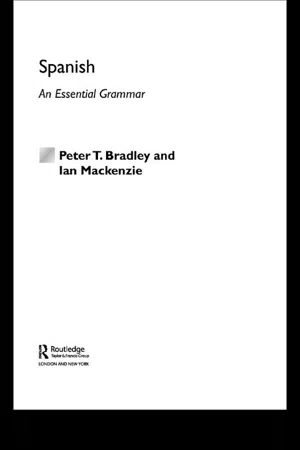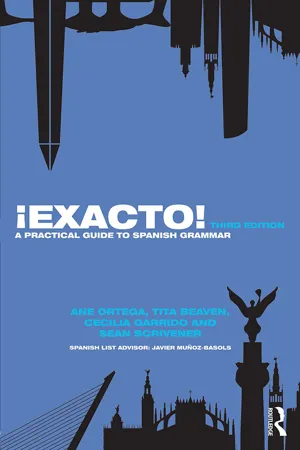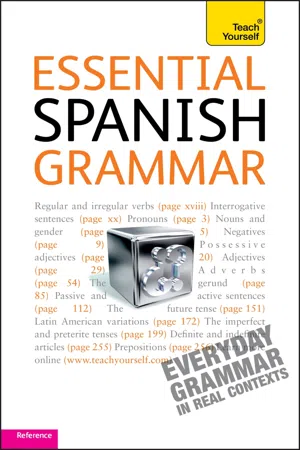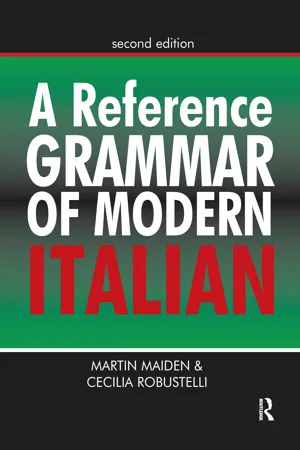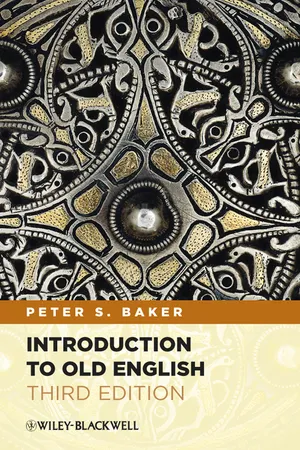Languages & Linguistics
Possessive Adjectives
Possessive adjectives are used to indicate ownership or possession in a sentence. They modify a noun to show who or what it belongs to. In English, common possessive adjectives include "my," "your," "his," "her," "its," "our," and "their." These adjectives help clarify relationships and ownership within a sentence.
Written by Perlego with AI-assistance
Related key terms
Related key terms
1 of 4
Related key terms
1 of 3
6 Key excerpts on "Possessive Adjectives"
- eBook - ePub
- Peter T Bradley, Ian Mackenzie(Authors)
- 2004(Publication Date)
- Routledge(Publisher)
Possessive AdjectivesPossessive Adjectives are used to indicate a relationship of possession or association, usually between a person and a thing. For example, the English word ‘my’ in the phrase ‘my book’ indicates that the book belongs to the person speaking. Each possessive adjective corresponds to a subject pronoun. For example, English ‘my’ is the possessive adjective for ‘I’ and ‘your’ is the possessive adjective for ‘you’.5.1 Possessive Adjectives before the noun
The following forms are used before a noun, but another adjective may come between them and the noun:Subject pronoun Possessive adjective yo mi/mis my tú, vos [LA] tu/tus your él/ella/usted su/sus his/her/its/your nosotros/-as nuestro/-os/-a/-as our vosotros/-as [SP] vuestro/-os/-a/-as [SP] your ellos/ellas/ustedes su/sus their/your All the Possessive Adjectives agree in number, but only nuestro and vuestro [SP] have distinct feminine forms. The agreement is with the noun possessed (not with the possessor):mis hijas my daughters nuestra maleta our suitcase ¿Cantás (vos) tu propia canción? Are you singing your own song? Note: In contrast with English, the Spanish possessive adjective is repeated before each noun in a list, except where they refer to the same person or thing, or to parts of the same overall concept: Tu primo y tu tío vivieron en Jaén ‘Your cousin and uncle lived in Jaén’, but mi colega y amigo, el Sr. Ortiz ‘my colleague and friend Mr Ortiz’, mis libros y artículos ‘my books and articles’.5.2 Possessive Adjectives after the noun
The following ‘strong’ or ‘stressed’ forms are used after a noun:
All the strong Possessive Adjectives agree in number and gender with the noun possessed. They can be used after a noun with meanings such as ‘of mine’, ‘of yours’:Subject pronoun Possessive adjective yo mío/-os/-a/-as mine tú, vos [LA] tuyo/-os/-a/-as yours él/ella/usted suyo/-os/-a/-as his/hers/yours nosotros/-as nuestro/-os/-a/-as ours vosotros/-as [SP] vuestro/-os/-a/-as [SP] yours ellos/ellas/ustedes suyo/-os/-a/-as theirs/yours - eBook - ePub
¡Exacto!
A Practical Guide to Spanish Grammar
- Ane Ortega, Tita Beaven, Cecilia Garrido, Sean Scrivener(Authors)
- 2018(Publication Date)
- Routledge(Publisher)
PossessivesPossessives – los posesivos – are words that indicate possession or belonging, such as mis libros (my books) or Es mío (It’s mine ).7.1 Possessive Adjectives
Possessive Adjectives – los adjetivos posesivos – agree in gender and number with the nouns they accompany.Possessive Adjectives before a noun
Possessives can replace the article to express possession: el coche (the car) → mi coche (my car).Possessive adjective Example mi, mis mi coche(my car),mis amigos(my friends)tu, tus tu casa(your house),tus cosas(your things)su, sus su trabajo(= el trabajo de él : his job; = el trabajo de ella : her job; = el trabajo de usted : your job)sus hijos(= los hijos de él : his children; = los hijos de ella : her children; = los hijos de usted : your children)nuestro, nuestra, nuestros, nuestras nuestro dinero(our money);nuestra salud(our health);nuestros amigos(our friends);nuestras bicicletas(our bicycles)vuestro, vuestra, vuestros, vuestras vuestro dinero(your money);vuestra salud(your health);vuestros amigos(your friends);vuestras bicicletas(your bicycles)su, sus su trabajo(= el trabajo de ellos : their job; = el trabajo de ellas : their job; = el trabajo de ustedes : your job)sus hijos(= los hijos de ellos : their children; = los hijos de ellas : their children; = los hijos de ustedes : your children)Notice that in Spanish, unlike in English, Possessive Adjectives agree with the gender and number of the thing possessed:nuestras bolsas → our bags (because the thing possessed is feminine and plural).nuestro equipaje → our luggage (because the thing possessed is masculine and singular).Su : avoiding ambiguitySu - eBook - ePub
- Goold Brown(Author)
- 2004(Publication Date)
- Perlego(Publisher)
Some individuals, however, are still dissatisfied. In the first place, against those who have thought otherwise, it is determined, by infinite odds of authority, that there is such a case, both of nouns and of pronouns. Many a common reader will wonder, who can have been ignorant enough to deny it. "The learned and sagacious Wallis, to whom every English grammarian owes a tribute of reverence, calls this modification of the noun an adjective possessive ; I think, with no more propriety than he might have applied the same to the Latin genitive."— Dr. Johnson's Gram., p. 5. Brightland also, who gave to adjectives the name of qualities, included all possessives among them, calling them " Possessive Qualities, or Qualities of Possession."— Brightland's Gram., p. 90. OBS. 11.—This exploded error, William S. Cardell, a few years ago, republished as a novelty; for which, among other pretended improvements of a like sort, he received the ephemeral praise of some of our modern literati. William B. Fowle also teaches the same thing. See his Common School Gram., Part II, p. 104. In Felch's Grammar, too, published in Boston in 1837, an attempt is made, to revive this old doctrine; but the author takes no notice of any of the above-named authorities, being probably ignorant of them all. His reasoning upon the point, does not appear to me to be worthy of a detailed answer.[165] That the possessive case of nouns is not an adjective, is demonstrable; because it may have adjectives of various kinds, relating to it: as, " This old man's daughter."— Shak. It may also govern an other possessive; as, " Peter's wife's mother."— Bible. Here the former possessive is governed by the latter; but, if both were adjectives, they would both relate to the noun mother, and so produce a confusion of ideas. Again, nouns of the possessive case have a distinction of number, which adjectives have not. In gender also, there lies a difference - eBook - ePub
- Juan Kattan-Ibarra(Author)
- 2012(Publication Date)
- Teach Yourself(Publisher)
6
Expressing possession
In this unit, you will learn how to:- express possession
- ask questions regarding possession
- Possessive Adjectives and pronouns
- using de to indicate possession
- ser used with a possessive
- expressing possession with tener
- definite article to express possession
- pertenecer
Key sentences
We can express possession in a variety of ways in English, for example: That is my house, It’s mine, Whose car is that?, It’s Peter)s, Have you got a computer?, I don’t have one . Spanish also has a number of ways of expressing possession. These involve some of the constructions learned in previous units.EXPRESSING POSSESSION
Esta es mi/su bicicleta.This is my/his/her bicycle. Tus/Sus llaves están aquí.Your/His/Her keys are here. Nuestras/Vuestras maletas son esas.Our/Your suitcases are those ones. El dinero es mío/tuyo .The money is mine/yours. La carpeta de Ana es la azul.Ana’s file is the blue one. Tenemos/Tienen una casa.We/They have a house. ASKING QUESTIONS REGARDING POSSESSION
¿ De quién es este periódico?Whose newspaper is this? ¿ A quién pertenece la propiedad?Who does the property belong to? ¿ Tiene Vd./Tienes coche?Have you got a car? Grammar summary
1 Possessive Adjectives AND PRONOUNS (MY, MINE, YOUR, YOURS, ETC.)
To express possession, we may, as in English, use possessives. Spanish has two sets of possessives: short forms such as mi my , tu your (familiar) and long forms such as mío mine , tuyo yours (familiar).a Short forms
Short forms function as adjectives and they all agree in number (singular or plural) with the noun they accompany, but only those ending in -o in the masculine singular (nuestro, vuestro ) agree in gender (masculine or feminine). Note that this agreement is with the thing possessed - eBook - ePub
- Professor Martin Maiden, Dr Cecilia Robustelli, Martin Maiden, Cecilia Robustelli(Authors)
- 2014(Publication Date)
- Routledge(Publisher)
Forms of the possessive adjectiveSingular Plural 1sg. mio mia miei mie 2sg. tuo tua tuoi tue 3sg. suo sua suoi sue 1pl. nostro nostra nostri nostre 2pl. vostro vostra vostri vostre 3pl. loro The relative possessive (see 7.8 ) is cui .Unlike English, the third person possessives do not indicate the sex of the possessor in the third person singular. e.g., la sua faccia ‘his/her/its face’.What differentiates the Italian possessive adjective from its English counterpart is that the former is really an adjective much like any other, in that:● With the exception of loro and cui , which are invariant, the other possessives agree for gender and number with the noun they modify:Alcune dame non possono neanche sedersi tanto sono elaborate e gonfie le loro gonne. ‘Some ladies can't even sit, so elaborate and puffed out are their skirts.’ La brigata nera tornava spesso nei suoi discorsi. ‘The black brigade was a recurrent theme in his speeches.’ Era andata ad assicurarsi che non fosse successo nulla alla sua vicina. ‘She had gone to make sure nothing had happened to her neighbour.’ Non sopportiamo più la nostra condizione. ‘We can't stand our condition any more.’ etc. ● Just as ordinary noun phrases may begin with a determiner (article, demonstrative, etc., e.g., il bel ragazzo ‘the handsome lad’, questo bel ragazzo ‘this handsome lad’), so a noun phrase containing a possessive adjective may begin with a determiner. In fact the Possessive Adjectives are usually preceded by the appropriate definite article , so that the normal expression for ‘my cat’, etc. would be il mio gatto , etc., but other determiners – indefinite article, partitive article (or partitive zero), demonstrative, numeral, quantifier – are all possible, and the rules for using or not using the definite, indefinite or partitive determiners with noun phrases containing possessives are exactly the same as those for any other noun phrase (see Chapter 4 ). Note that the indefinite article + possessive (e.g., un amico mio/tuo - eBook - ePub
- Peter S. Baker(Author)
- 2012(Publication Date)
- Wiley-Blackwell(Publisher)
Words can move from one part of speech to another in Old English as they can in Modern English: often the same word can function as a conjunction or an adverb, for example, or as a pronoun or an adjective. In addition, Old English, like Modern English, has rules for altering a word’s part of speech. In this section, and in the rest of this book, we will keep in mind that the ‘part of speech’ is a grammatical and not a semantic category; but we will allude to the more traditional way of defining parts of speech when it is helpful to do so.3.1.1 Nouns
A noun is the name of a person, place or thing. The ‘thing’ need not be concrete: for example, it can be a thought, an activity or a principle.The noun may be inflected (endings supplied or its form altered) to mark its number (singular or plural) or case (in Modern English, subjective/objective or possessive – but there are more cases in Old English).3.1.2 Pronouns
According to the classic definition, a pronoun is a word used in place of a noun. However, a pronoun can also work like an adjective, modifying the meaning of a noun rather than replacing it. While the more familiar kind of adjective may modify or limit the meaning of a noun in a novel way, creating, just possibly, a concept that has never been spoken of before (‘a transcendental cow’, ‘a nuclear teapot’), the pronominal adjective modifies the sense of the noun by narrowing its reference in a very limited and stereotyped way: ‘this cow’ (the one here with me), ‘each teapot’ (all of them, but considered one by one). As the ‘classic’ pronoun and the pronominal adjective generally have the same form, this book treats them as equivalent.Pronouns are of seven types: personal, demonstrative, interrogative, indefinite, relative, reflexive and reciprocal. Here is a rundown of these types:Personal. The personal pronouns (Modern English I, you, she, he, it, etc.) refer to specific objects and are inflected for person – the first person referring to the speaker, the second person to someone or something the speaker is addressing, and the third person to any other person or thing.Demonstrative. These pronouns point out specific things (Modern English this, that). The Modern English definite article the
Index pages curate the most relevant extracts from our library of academic textbooks. They’ve been created using an in-house natural language model (NLM), each adding context and meaning to key research topics.
Explore more topic indexes
Explore more topic indexes
1 of 6
Explore more topic indexes
1 of 4
